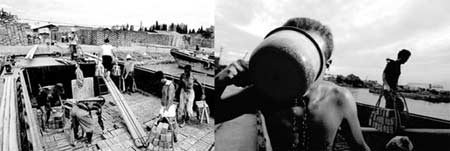
(Left): Workers unload bricks at Chengbei Dock in Hangzhou, Zhejiang province. (Right): Dinner at one of the shared rooms at the dock.
Built 2,400 years ago, the Grand Canal linking Beijing and Hangzhou in East China's Zhejiang province, was the country's most important transport link, and was used to ship grains and goods between the south and the north. At a time when there were no trains or highways, it served to connect the whole of China.
Chen Yunshan from Guizhou province in Southwest China came to the suburbs of Hangzhou as a dock workers, six years ago. Last year, Chen says he earned 23,948 yuan (3,326 U.S. dollars) unloading bricks from boats.
This is not a big sum in the city. But Chen says if he makes the same amount this year, he will be able to build a house in his hometown.

|
(Left): Brick, coal and sand made up the bulk of the cargo. Photos by Li Qizheng (Right): A dock worker stops for a drink of water.
Every morning, Chen begins work at 4. One shipload of bricks usually takes seven people three days to unload. The workers take a rest at noon. About 200 people work alongside Chen and they share rooms in the sheds at the dock.
But Chen may not be aware of the Canal's importance in history. For centuries, it was the top choice for long-distance transportation. Many emperors inspected the country in grand ships plying the Canal.
The Canal has changed greatly with trucks, trains and planes taking over the transportation task. But it has not been abandoned. In Shandong, Jiangsu and Zhejiang provinces, the Canal continues to thrive, meeting the needs of local transportation.
Brick, coal and sand make up the bulk of the shipping cargo, contributing to the boom in cities lying alongside the Canal and offering opportunities to people such as Chen.
(China Daily April 8, 2008) |